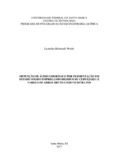| dc.creator | Werle, Leandro Bernardi | |
| dc.date.accessioned | 2018-06-19T20:07:45Z | |
| dc.date.available | 2018-06-19T20:07:45Z | |
| dc.date.issued | 2017-03-21 | |
| dc.identifier.uri | http://repositorio.ufsm.br/handle/1/13464 | |
| dc.description.abstract | Gibberellic acid (GA3), a phytohormone belonging to the group of gibberellins is widely used in agricultural formulations, since it allows increased productivity in different types of crops. Due to the high final cost of production of GA3, new processes for the production of the hormone have been studied, among them Solid State Fermentation (SSF). Through this fermentation it is possible to increase the concentration of the GA3 obtained, as well as to use agroindustrial substrates of low commercial value abundant in the Santa Maria region as crude rice bran (CRB) and wet brewery residue (WBR). Thus, the objective of this work was to evaluate the production of GA3 by SSF using WBR and CRB substrates and using a strain of Gibberella fujikuroi. Initially the characterization of the substrates was performed, and it was possible to verify from the results that both present great potential as sources of nutrients because they are rich in carbon and nitrogen. An central composite rotational design (CCRD) was carried out, with a 23 to 3 variables totalling 17 experiments, with 3 replicates to the central point, to investigate the influence of the initial moisture content of the substrate (50 to 70 %), The proportion of rice bran in the substrate (0 to 50% by weight) and inorganic nitrogen content (0 to 2 g / kg of substrate). After 6 days of cultivation, the best GA3 yield (0.93 g / kg substrate) occurred for the conditions (65.95% moisture, 10.12% rice bran and 1.6 g N Inorganic / kg substrate). Finally, the condition of higher yield was used to verify the kinetic profile of GA3, it was possible to verify an increase in the production of the hormone, mainly from day 4, and the maximum production (1.31 g / kg of substrate) occurred on the 10th day of fermentation, with a gradual reduction in hormone production. | eng |
| dc.language | por | por |
| dc.publisher | Universidade Federal de Santa Maria | por |
| dc.rights | Attribution-NonCommercial-NoDerivatives 4.0 International | * |
| dc.rights.uri | http://creativecommons.org/licenses/by-nc-nd/4.0/ | * |
| dc.subject | Ácido giberélico | por |
| dc.subject | Fermentação em estado sólido | por |
| dc.subject | Resíduos agroindustriais | por |
| dc.subject | Gibberellic acid | eng |
| dc.subject | Solid state fermentation | eng |
| dc.subject | Agro-industrial waste | eng |
| dc.title | Obtenção de ácido giberélico por fermentação em estado sólido empregando resíduo de cervejaria e farelo de arroz bruto como substratos | por |
| dc.title.alternative | Obtention of gibberellic acid by solid state fermentation employing brewery residue and crude rice brand as substrates | eng |
| dc.type | Dissertação | por |
| dc.description.resumo | O Ácido Giberélico (GA3), fitohormônio pertencente ao grupo das giberelinas, vem se destacando por ser utilizado largamente em formulações agrícolas, uma vez que possibilita aumento na produtividade em diferentes tipos de cultura. Devido ao elevado custo final de produção do GA3, novos processos para produção do hormônio vem sendo estudados, dentre eles a Fermentação em Estado Sólido (FES), podendo aumentar a concentração do GA3 obtido, além de utilizar substratos agroindustriais de baixo valor comercial abundantes na região de Santa Maria como farelo de arroz bruto (FAB) e resíduo de cervejaria úmido (RCU). Assim, objetivo deste trabalho foi avaliar a produção de GA3 por FES empregando como substratos RCU e FAB e utilizando uma cepa de Gibberella fujikuroi. Inicialmente foi realizada a caraterização dos substratos, sendo possível verificar a partir dos resultados que ambos apresentam grande potencial como fontes de nutrientes por serem ricos em carbono e nitrogênio. Na sequencia, foi realizado um planejamento experimental do tipo delineamento composto central rotacional (DCCR) do tipo 23 para 3 variáveis totalizando 17 experimentos, com 3 repetições no ponto central, para investigar a influência do teor inicial de umidade do substrato (50 a 70%), a proporção do farelo de arroz no substrato (0 a 50% em peso) e teor de nitrogênio inorgânico (0 a 2 g / kg de substrato). Após 6 dias de cultivo em béqueres, o melhor rendimento de GA3 (0,93 g / kg de substrato) ocorreu para as condições (65,95% de umidade, 10,12% de farelo de arroz e 1,6 g de N inorgânico/Kg de substrato). Finalmente, a condição de maior rendimento foi utilizada para verificar o perfil cinético de GA3, foi possível verificar um aumento da produção do hormônio, principalmente a partir do 4º dia, sendo que a máxima produção (1,31 g / kg de substrato) ocorreu no 10º dia de fermentação, ocorrendo a partir daí uma redução gradativa na produção do hormônio. | por |
| dc.contributor.advisor1 | Jahn, Sérgio Luiz | |
| dc.contributor.advisor1Lattes | http://lattes.cnpq.br/7735147410610776 | por |
| dc.contributor.referee1 | Mazutti, Márcio Antonio | |
| dc.contributor.referee1Lattes | http://lattes.cnpq.br/3520282081196395 | por |
| dc.contributor.referee2 | Silva, Juliana Rosemara Felisberto da | |
| dc.contributor.referee2Lattes | http://lattes.cnpq.br/4930278030284534 | por |
| dc.creator.Lattes | http://lattes.cnpq.br/9037726568759071 | por |
| dc.publisher.country | Brasil | por |
| dc.publisher.department | Engenharia Química | por |
| dc.publisher.initials | UFSM | por |
| dc.publisher.program | Programa de Pós-Graduação em Engenharia Química | por |
| dc.subject.cnpq | CNPQ::ENGENHARIAS::ENGENHARIA QUIMICA | por |
| dc.publisher.unidade | Centro de Tecnologia | por |



